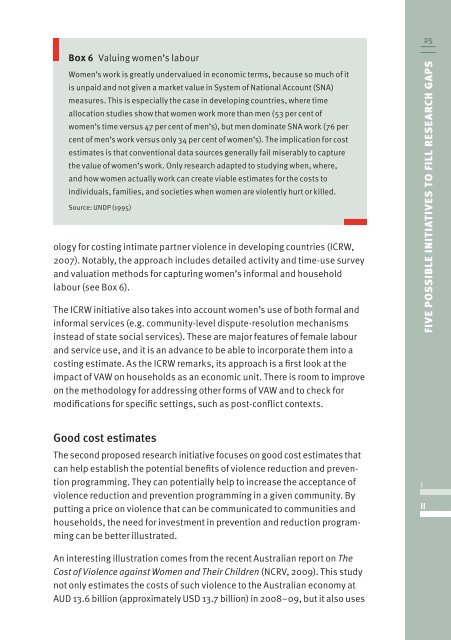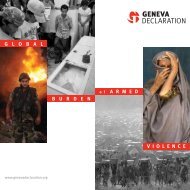Tackling Violence against Women: From Knowledge to Practical
Tackling Violence against Women: From Knowledge to Practical
Tackling Violence against Women: From Knowledge to Practical
Create successful ePaper yourself
Turn your PDF publications into a flip-book with our unique Google optimized e-Paper software.
Box 6 Valuing women’s labour<br />
women’s work is greatly undervalued in economic terms, because so much of it<br />
is unpaid and not given a market value in System of National Account (SNA)<br />
measures. This is especially the case in developing countries, where time<br />
allocation studies show that women work more than men (53 per cent of<br />
women’s time versus 47 per cent of men’s), but men dominate SNA work (76 per<br />
cent of men’s work versus only 34 per cent of women’s). The implication for cost<br />
estimates is that conventional data sources generally fail miserably <strong>to</strong> capture<br />
the value of women’s work. Only research adapted <strong>to</strong> studying when, where,<br />
and how women actually work can create viable estimates for the costs <strong>to</strong><br />
individuals, families, and societies when women are violently hurt or killed.<br />
Source: UNDp (1995)<br />
ology for costing intimate partner violence in developing countries (ICRw,<br />
2007). Notably, the approach includes detailed activity and time-use survey<br />
and valuation methods for capturing women’s informal and household<br />
labour (see Box 6).<br />
The ICRw initiative also takes in<strong>to</strong> account women’s use of both formal and<br />
informal services (e.g. community-level dispute-resolution mechanisms<br />
instead of state social services). These are major features of female labour<br />
and service use, and it is an advance <strong>to</strong> be able <strong>to</strong> incorporate them in<strong>to</strong> a<br />
costing estimate. As the ICRw remarks, its approach is a first look at the<br />
impact of VAw on households as an economic unit. There is room <strong>to</strong> improve<br />
on the methodology for addressing other forms of VAw and <strong>to</strong> check for<br />
modifications for specific settings, such as post-conflict contexts.<br />
Good cost estimates<br />
The second proposed research initiative focuses on good cost estimates that<br />
can help establish the potential benefits of violence reduction and prevention<br />
programming. They can potentially help <strong>to</strong> increase the acceptance of<br />
violence reduction and prevention programming in a given community. By<br />
putting a price on violence that can be communicated <strong>to</strong> communities and<br />
households, the need for investment in prevention and reduction programming<br />
can be better illustrated.<br />
An interesting illustration comes from the recent Australian report on The<br />
Cost of <strong>Violence</strong> <strong>against</strong> <strong>Women</strong> and Their Children (NCRV, 2009). This study<br />
not only estimates the costs of such violence <strong>to</strong> the Australian economy at<br />
AUD 13.6 billion (approximately USD 13.7 billion) in 2008–09, but it also uses<br />
25<br />
FiVE PossiBlE iNiTiATiVEs To Fill REsEARcH GAPs<br />
i<br />
ii









